Guide to Self Storage Real Estate Gains Taxes
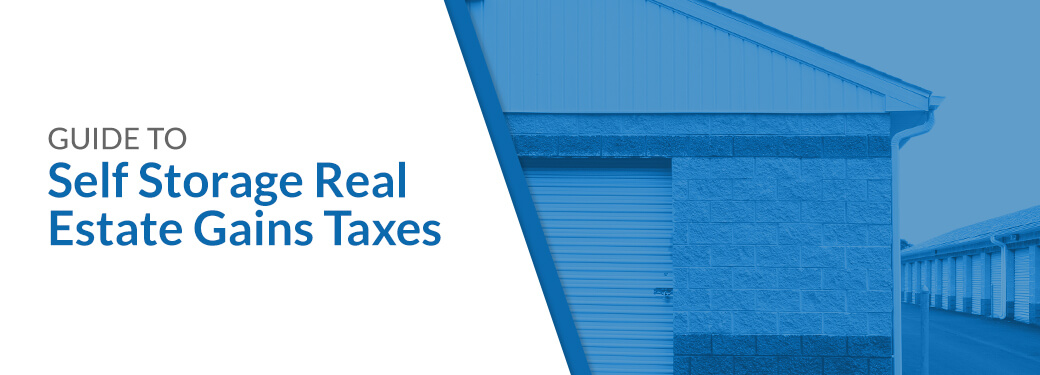
Over the past few years, self storage has become an increasingly appealing investment. The growing trend can be traced back to the U.S. financial crisis. By the time the crisis ended, funding for new construction had become nearly impossible to obtain. However, investors found that self storage properties performed well, even during the recession, and storage centers became an attractive hedge against potential similar issues in the future.
Self storage facilities are easy to manage, cheap to build and come with low staffing demands compared to similarly-sized buildings. If you own a self storage business, you may be wondering what taxes may be involved in a self storage investment sale. Taxation of self storage units can be complex and overwhelming, especially if you have never participated in self storage 1031 exchanges before.
If you are looking to sell self storage operating partnership units, you should understand taxes when selling self storage property. This guide covers self storage real estate gains taxes to help you navigate the process and choose the best tax mitigation strategies for selling self storage units.
Table of Contents
- Capital Gains Tax When Selling Commercial Real Estate
- What Is a Capital Gains Tax?
- What Are Long-Term Capital Gains Taxes for Self Storage?
- How Can You Mitigate Taxes When Selling Self Storage?
- Like-Kind Exchanges Under IRC Section 1031 for Self Storage
- What Are Like-Kind Exchanges and How Do They Work?
- What Are the Different Types of Exchanges?
- What Is the Process for a 1031 Exchange?
- What Qualifies as a 1031 Exchange?
- What Are the Benefits of Using a 1031 Exchange?
- How Does a 1031 Exchange Work for Self Storage?
- Tax-Deferred Installment Sales
- What Are Tax-Deferred Installment Sales?
- How Do You Report Income From an Installment Sale?
- What Are the Self Storage Tax Benefits of an Investment Sale?
- What Are the Risks Associated With Tax-Deferred Installment Sale?
- Estate Planning Through Entity Restructuring
- How Do UPREIT and OP Work?
- How Do UPREIT and OP Help With Tax Planning?
- Work With a Broker and Expert From Investment Real Estate, LLC
Capital Gains Tax When Selling Commercial Real Estate
When selling, self storage capital gains taxes can affect your decisions, so it’s important to understand what they are and how they work.
What Is a Capital Gains Tax?
Capital gains are profit from an investment sold for more than its original purchase price. A capital gains tax is a tax on that profit.
However, when that investment is real estate, the original real estate price can be adjusted to reduce capital gains. On acquisition, a cost or tax basis, which includes transfer taxes and legal fees, becomes a part of the property’s purchase price. During ownership, an adjusted basis calculation that typically includes capital improvements, such as a roof replacement, can increase the purchase cost and reduce capital gains on future sales.
In addition to federal taxes, several states also impose capital gains taxes. While some states permit taxpayers to deduct the federal income tax they pay from their state taxable income, other states have special rules for capital gains income. For example, if a state has no income tax, it may compensate for this by implementing high real estate tax and sales tax rates.
What Are Long-Term Capital Gains Taxes for Self Storage?
When you own real estate property for longer than a year, the gains you earn when you sell the property are classified as long-term gains. To calculate your long-term capital gains, take your sale’s adjusted gross proceeds and subtract your property’s adjusted cost.
How Can You Mitigate Taxes When Selling Self Storage?
Tax strategies for selling self storage in tax-deferred exchanges can save you money. By utilizing the following strategies, you may be able to minimize or avoid capital gains tax when selling self storage:
- Transfer to charitable remainder trusts (CRTs): You can transfer your appreciated assets tax-free to CRTs for a certain term. As the trustee, you can sell these assets, allowing your proceeds to compound tax-free since CRTs are tax-exempt. You receive distributions periodically as ordinary income, and when the trust ends, part of the money will be used for charity. However, your tax savings will likely dwarf this loss.
- Deduct capital losses: A capital loss occurs when a qualifying event like an investment property sale results in a loss. You sustain a loss when the sales price is less than the original purchase price. To be eligible for a capital loss, you must have held the property for investment rather than personal use. Until capital losses are exhausted, you can use them to offset your capital gains.
- Hold the property longer than a year: When you hold a property long-term, you may be eligible for capital gains tax benefits. Your real estate sale profits will be taxed at long-term rates based on your filing status and taxable income. Short-term tax rates are much higher, so you can save money if you can qualify for a long-term rate.
- Pursue a 1031 tax-deferred exchange: For self storage, 1031 like-kind exchanges may allow you to defer paying your capital gains, income taxes and depreciation recapture by reinvesting the sale proceeds in a different investment property.
Tax deferment strategies can save a lot of money, so keep these in mind when you are ready to sell commercial or investment real estate.
Get Self Storage Tax Deferment Guidance Today
Like-Kind Exchanges Under IRC Section 1031 for Self Storage
When you sell an investment or business property and have a gain, you typically need to pay tax on this gain at the time of the sale. However, an exception under IRC Section 1031 enables you to postpone your tax payment on the gain as long as you reinvest your proceeds in a similar property during a qualified like-kind exchange. A gain deferred through a like-kind exchange is tax-deferred, though it is not tax-free under IRC Section 1031.
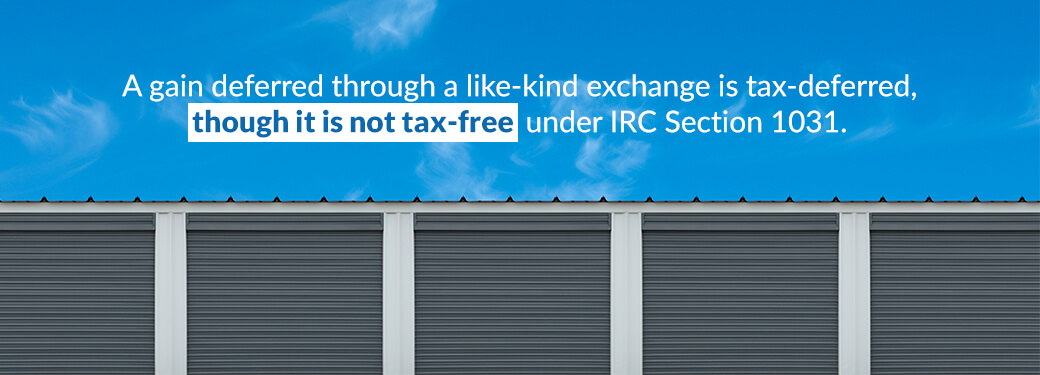
What Are Like-Kind Exchanges and How Do They Work?
In a like-kind exchange, like-kind property is used alone or like-kind property can be included with property, cash and liabilities that are not considered like-kind. If your exchange is not like-kind, this could trigger a taxable gain in the year of your exchange. In the same transaction, there can be deferred and realized gain if you exchange for a like-kind property with a lower value.
If you exchange for non-like-kind money or property, you need to recognize a gain on the other money and property received. You cannot recognize a loss. Properties can differ in quality and can still be considered like-kind no matter whether they have been improved or not.
What Are the Different Types of Exchanges?

The different types of exchanges are known as deferred, forward, simultaneous, reverse and improvement.
- Deferred exchanges: Deferred exchanges can be more complex, but they also allow flexibility. With a deferred exchange, you can dispose of property and then acquire at least one like-kind replacement property. The acquisition of a replacement property and disposition of a relinquished property need to be mutually dependent in an integrated transaction that constitutes an exchange of property.
- Forward exchanges: Forward exchanges are used when you first sell your relinquished property and then acquire a replacement property. For the transaction, the documentation is simple and the costs are nominal. Though issues may arise with a forward exchange, a professional can easily identify and resolve them.
- Simultaneous exchanges: Simultaneous exchanges are used when two taxpayers want to swap property while keeping their original tax basis. Since it is improbable that two parties will be in such a situation, this type of exchange is rare.
- Reverse exchanges: Reverse exchanges are used when you locate a suitable replacement property before you sell your relinquished property. The two types of reverse exchanges depend on the property. One type is exchange first, where the qualified intermediary acquires a relinquished property on their client’s behalf. The other is exchange last, where the qualified intermediary acquires the replacement property. Compared to a forward exchange, transaction fees are higher, but a reverse exchange also helps solve the issue of timing.
- Improvement exchanges: Improvement exchanges are a kind of reverse exchange in which a qualified intermediary acquires undeveloped land, secures financing for construction and builds improvements. The improved asset is then transferred as a replacement property to complete the exchange. This structure can help solve the issue of value.
What Is the Process for a 1031 Exchange?
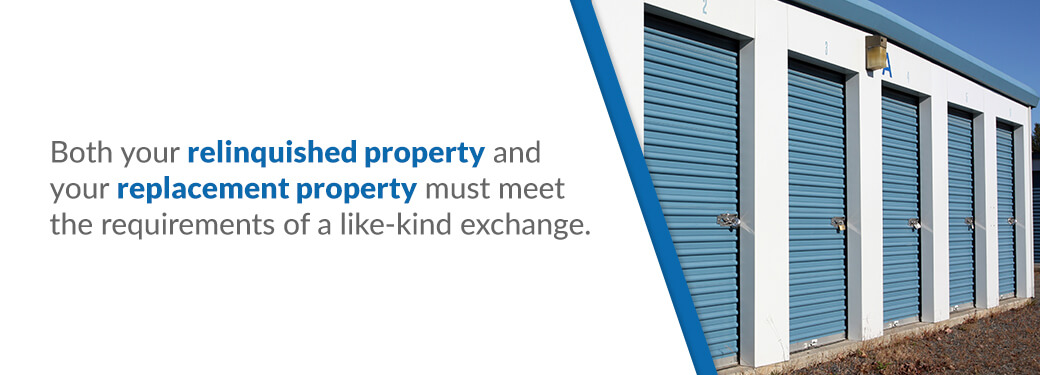
Though like-kind self storage tax-deferred 1031 exchange does not need to be a swap of properties that occurs simultaneously, you need to meet some time limits to avoid your entire gain being taxed. These limits can only be extended if the president declares a disaster.

First, you have 45 days after the day you sell your relinquished property to identify a potential replacement property. The identification should be written, signed, and submitted to a person involved in your 1031 exchange.
The other time limit is that you must receive your replacement property and complete the exchange no longer than 180 days after you sell your exchanged property or the due date of your income tax return in the year in which your property sold, whichever comes first.
What Qualifies as a 1031 Exchange?
Only certain investments can be used as exchange vehicles in a 1031 exchange. Both your relinquished property and your replacement property must meet the requirements of a like-kind exchange. Both of the properties should be similar and of the same class, character or nature. Other than self-storage, investments for 1031 exchanges that involve a type of real property asset are permitted as long as they are not inventory and are instead held for investment, such as:
- Land
- Apartments
- Office buildings
- Shopping centers
- Warehouse facilities
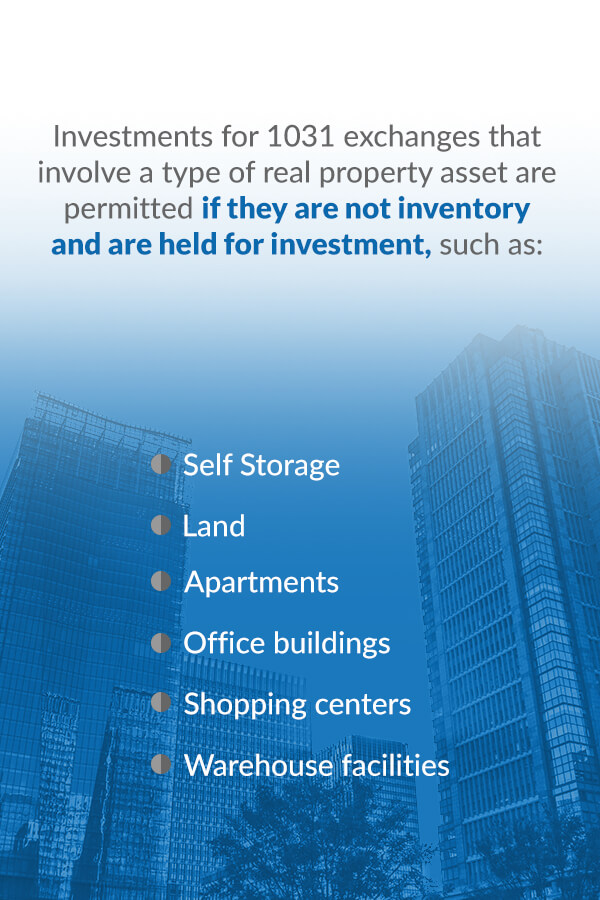
If you own investment or business property, you may be eligible for a Section 1031 deferral. Under Section 1031, individuals, S corporations, C corporations, partnerships, trusts and limited liability companies can exchange investment or business properties for other investment or business properties. Other investments do not qualify as a 1031 exchange, such as:
- Stocks
- Bonds
- Certificates of trusts
- Partnership interests
- Debt or securities
Generally, exchanges of equipment, machinery, artwork, vehicles, patents, collectibles, intangible business assets and intellectual property are not eligible for non-recognition of loss or gain as like-kind exchanges. Certain exchanges of irrigation stock, reservoir or mutual ditch may still be eligible for non-recognition of loss or gain in like-kind exchanges.
Additionally, properties used primarily for personal use, such as a vacation home or primary residence, do not qualify for like-kind exchanges. For example, unless a home is an investment and leased to guests to generate income, you cannot sell a self storage facility to buy a residential property.
It can be challenging to transact a direct exchange where you sell your facility in exchange for real property on the date of closing rather than for cash. For a true exchange, the buyer would need to purchase a new facility for the seller and, rather than pay a purchase price, they would pay with their new investment. While these transactions are possible, they can only be accomplished with great effort.
After losing several tax cases, the Internal Revenue Service (IRS) now recognizes the validity of a deferred, or delayed, exchange. This occurs when you sell your property, put the proceeds from the sale in an escrow account and use these proceeds to buy a new investment.
Speak to a Self Storage 1031 Exchange Expert
What Are the Benefits of Using a 1031 Exchange?
With a 1031 exchange, you can redeploy an investment into better-performing investment properties while deferring capital gains taxes. Other benefits of using a 1031 exchange include:
- The ability to build equity over the long term: There is no limit on the number of times you can participate in a 1031 exchange. Over time, this can allow you to build more equity.

- New exposure to growing markets: Maybe you are looking to invest in a market that seems to have the potential for growth. Since a like-kind exchange is not restricted to state lines, you can capitalize on the diversification of risk. When you get into a growing market early, you could enjoy greater returns later on.
- The chance to invest in a portfolio: During a like-kind exchange, a new investment needs to be an investment in real estate. If you are a real estate investor, you can exchange a property for a portfolio of other properties located in a more affordable state or a state with lower volatility. This can help you generate higher returns over time.
- The opportunity to trade up for a higher value property: With a self storage tax-deferred investment sale, you can trade up for a property or several properties that offer higher quality or returns that are better aligned with your investing goals. You also will not need to pay tax on your new investment until you sell it or exchange it in another 1031 exchange.
- Greater flexibility in exit strategies for self storage owners: If you purchase a portfolio of properties, for example, you will have the flexibility to sell some of your assets when you want to over time. While investing in commercial real estate can often create liquidity constraints, properties in a portfolio can be traded individually, offering you more freedom and flexibility.
- The ability to reset your depreciation: When you own property, you may be able to write off the depreciation of your asset to compensate for any deterioration related to aging, wear and tear or another obsolete structure of the property. If you’ve already reached the limit for writing off depreciation for your self storage facility, exchanging that asset for a new property can reset your depreciation.
How Does a 1031 Exchange Work for Self Storage?
Like office buildings and homes, a self storage facility can be sold like any property in the U.S. These facilities are typically sold at national and local levels to businesses and individuals. A 1031 exchange is similar to standard buying and selling transactions except any proceeds from the sale stay with a qualified intermediary to go toward the purchase of another property.

1. Determine Your Self Storage Facility’s Value
If you want to exchange a self storage facility in a 1031 exchange, you will first need to determine your self storage facility’s value. These facilities are frequently bought and sold, so you can likely find public records to identify the value of previous sales.
The best way to determine your self storage facility’s value is to find a sale of a similar property in your state or county. Factors that may affect your facility’s value include:
- Security
- Location
- Market trends
- Tenant capacity
- Property history
- Number of units
- Number of tenants
- Property maintenance
- Features and technology, such as air conditioning or keyless entry
While market fluctuations will impact the value of self storage facilities, the combination of the above factors and previous similar sales can give you an approximate value of the self storage facility. Working with a real estate agent can make valuing your property easier, especially if the facility is in a state where sales prices aren’t public.
2. Choose a Qualified Intermediary
When selling a self storage facility as part of a 1031 exchange, you need to work with a qualified intermediary, also referred to as a QI. Working with a QI through the sale, purchase and exchange ensures the exchange is completed legally.

When choosing a QI to work with, look for someone with the following:
- Personal service: Your intermediary should assist you throughout the entire process with resolving any issues related to structuring and finishing your exchange. An intermediary’s personal service should complement the services of your tax advisor.
- Expertise: An experienced intermediary will have several years of experience handling exchange transactions. You deserve to work with an intermediary who has the experience necessary to ensure your exchange is successful and as beneficial as possible for you.
- Communication: Choose a qualified intermediary who is willing to define their compensation package clearly. You deserve a QI who communicates openly and honestly with you. Your intermediary should also communicate reminders and important deadlines to you.
- References: Ask the qualified intermediary for references and call these contacts to ask about the intermediary’s experience, knowledge and communication.
3. Report the Like-Kind Exchange to the IRS

Self storage like-kind exchanges must be reported to the IRS. You will report the exchange on Form 8824 and file it with your tax return. On this form, you will need to provide information on the following:
- The realized gain
- Cash paid or received
- Liabilities assumed or relieved
- The value of the received property
- Descriptions of the exchanged properties
- Any relationship the parties have to the exchange
- Adjusted basis of the relinquished like-kind property
- The dates the properties were identified and transferred
- Loss or gain on the sale of any relinquished non-like-kind property
If you do not follow the rules set for a like-kind exchange, you may be liable for penalties, interest and taxes on your transactions.
Tax-Deferred Installment Sales
What is your tax liability when selling self storage units? For the sale of a self storage facility, you may pay federal income taxes, sales taxes, capital gains taxes and local taxes, depending on your location.
When you sell a rental property for a large profit, this can be a dream come true, allowing you to increase your net worth. If you want to maximize your profit from the sale of a rental property, you may want to defer accepting a lump sum of your earnings.
What Are Tax-Deferred Installment Sales?
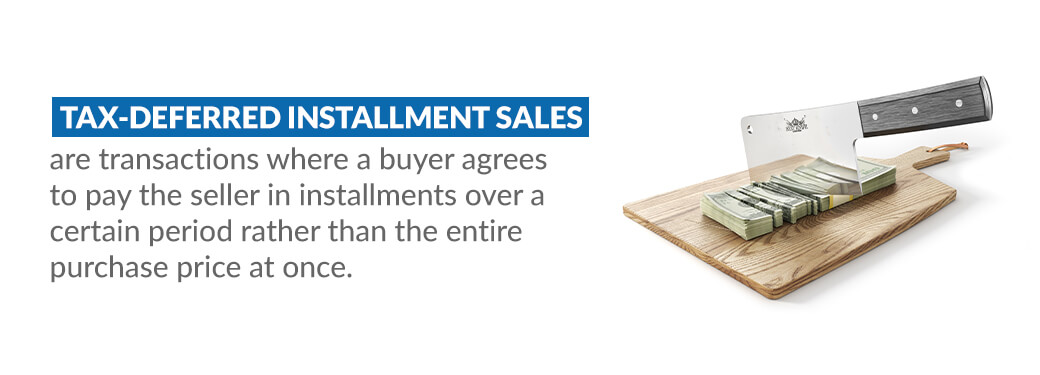
When you are considering how to defer taxes when selling self-storage, you may want to pursue a tax-deferred installment sale. Tax-deferred installment sales are transactions where a buyer agrees to pay the seller in installments over a certain period rather than the entire purchase price at once.
This is determined in the installment contract and is typically 30 years. However, any sale can be an installment sale if at least one payment is made after the tax year of the property’s sale.
The other component of an installment sale is what the buyer and seller agree on for how the sale’s proceeds will be placed to give the seller the most benefits in the deferral period. Financial and tax risk management companies often structure these transactions.
From a tax perspective, taking your payment as a lump sum may not be in your best interest. For example, if you declare the entire proceeds of your sale as income in the same year you sell the property, you will pay a large portion of your gain that corresponds to depreciation deductions you have previously taken on your rental property.
Any gain above the depreciation recapture is also taxed at a high rate. Fortunately, an installment sale agreement can be used to reduce your annual taxable income.
How Do You Report Income From an Installment Sale?
Income from an installment sale is categorized as principal, interest and capital gain. On Form 1040, each category is treated differently. Your gross profit percentage is used to determine your installment sale income for the tax year.
- Principal: The IRS considers part of every installment sale to be a tax-free return of principal. For installment sale purposes, the principal is the total amount of the actual adjusted basis in your property, along with any depreciation recapture and selling expenses.
- Interest: If you have installment sale income, you need to report the interest you charge to the buyer. This interest is taxed at standard income rates. When interest is provided in your sales contract, this is known as stated interest. If your stated interest is considered insufficient, part of your sale’s principal portion should be recharacterized as unstated interest.
- Capital gain: Your capital gain will impact how you are taxed. For example, if you have a long-term gain, this will be taxed at a lower rate. On the other hand, if you have a short-term gain, this will be taxed as ordinary income. Even with a short-term gain, however, you may be taxed at a lower rate for an installment sale than if you declared a lump sum gain.
You can calculate your gross profit percentage by subtracting the adjusted basis from the sale price. This will give you the total gain. Then you will divide your total gain by the sale price, which gives you the gross profit percentage. To calculate your taxable gain every year, you can multiply your gross profit percentage by the installment amount.
Learn More About Self Storage Installment Sales
What Are the Self Storage Tax Benefits of an Investment Sale?
When you defer a portion of your gain from an investment property sale through an installment sale agreement, you can declare a prorated portion of your capital gains across several years. Although an installment sale mandates that you wait years before you receive your property’s fair market value in full, you can enjoy the following tax advantages by choosing a tax-deferred installment sale:
- Tax deferral: Rather than pay tax on your entire gain in a single year, only part of your gain is taxable during the year you made the sale. The remainder of the gain is taxable in the years that you receive payments. Each payment’s taxable portion is calculated using the gross profit ratio, which is determined by dividing your gross profit from your sale by the price.
- Long-term capital gains: When real estate is sold in an installment sale, any gains are taxed as tax-favored, long-term gains if you have owned the property longer than a year. For example, according to the current tax laws, the maximum rate for long-term capital gains is 15% or 20% if your tax bracket is 39.6%. Even if you are liable for the net investment income tax (NIIT) of 3.8%, the maximum total federal tax rate is 23.8%.
- Lower tax liability: Since the gain is from your installment sale is spread over multiple years, you may benefit financially from the tax rate differential each year that you receive payments.
You may also be able to lower the amount of tax you need to pay by deducting your process, market and legal fees. With an installment sale, you may also be more likely to make the sale or obtain a better price. Installment sales appeal to buyers who lack sufficient cash to pay for a facility in a lump sum for the price you are asking.
What Are the Risks Associated With Tax-Deferred Installment Sale?
As a seller, you may also face some tax risks when you choose an installment sale. Depreciation recapture needs to be reported as gain during the year you make the sale, regardless of the amount of cash you are paid.

In some cases, you may owe more in taxes that year than you received in cash proceeds from the sale. If you believe you may face this issue with depreciation recapture, ensure you have additional funds to cover your tax bill.
If your tax rate increases, you may end up with a larger tax bill. Weigh this risk against the benefits of choosing an installment sale to determine whether this is the right option for you.
Estate Planning Through Entity Restructuring
Generally, storage facilities are owned and managed through a legal entity, such as a limited partnership or limited liability company. While most sales of storage facilities involve an asset purchase transaction, certain instances of a deal could benefit from passing an entity to a purchaser through a stock or membership transaction over time.
Many third-party costs, such as transfer tax, can be avoided by not conveying by deed and keeping the ownership percentage transfers under certain annual amounts. Consulting a skilled estate planning attorney here can be useful.
How Do UPREIT and OP Work?
Self storage real estate investment trusts (REITs) are growing quickly. If you are looking to a REIT as an exit strategy from the self storage business, you should understand how umbrella partnership REITs (UPREITs) and operating partnerships (OPs) work before making an UPREIT self storage deferred sale.
An exit strategy should start with a property analysis that examines your business’s current stage in its life cycle. Are you facing competition and risk losing tenants with rate increases? Has the immediate market started to deteriorate economically? Is it challenging or impossible to expand your business with additional square footage? If these factors are present, this may indicate that your self storage facility is in the mature phase.
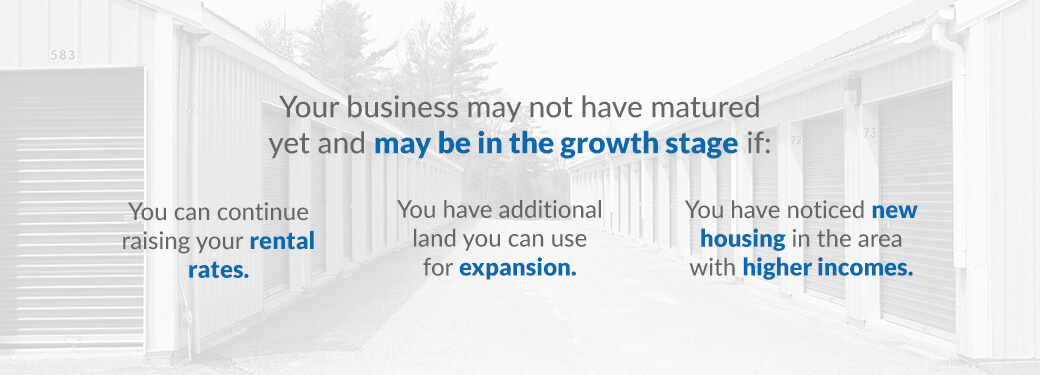
Your business may not have matured yet and may be in the growth stage if:
- You can continue raising your rental rates.
- You have additional land you can use for expansion.
- You have noticed new housing in the area with higher incomes.
Once you determine your business’s life cycle stage, you can examine the factors that have prompted your exit strategy. Other than the market, life events like illness, divorce, age or death of a partner can motivate selling or transferring ownership of a self storage facility. If you are not planning to sell outright, you need to have a succession plan as part of your long-term estate plan.
Even with market conditions being favorable for selling or transferring the ownership of a self storage facility, you can maximize your return on investment (ROI) by selling when your business is near or at the mature stage and your life events make it appropriate to pursue an exit strategy.
Many self storage facilities can offer OP units for compensation to sellers as an alternative to cash. With an UPREIT, you can own OP units. OP units represent limited partnership interests in an OP that owns these properties and can often be converted to common shares. OP units also have the same stock price and dividend volatility as REIT common shares.
You can use OP units in several different ways, such as pledging them as collateral or structuring a hybrid of preferred and common OP units. These units can also be convenient for estate and tax planning.
Get UPREIT and OP Guidance Today
How Do UPREIT and OP Help With Tax Planning?
UPREIT tax deferment for self storage can help you with your tax planning. An OP unit also allows you to defer your tax liability until you exchange the structure for REIT shares or cash. This can result in diversification and give you flexibility in how you receive your sale’s proceeds, whether you want all OP units, all cash or a mix of both.
You can use a self storage deferred sales trust to defer your capital gains tax. If you seek tax deferral, an UPREIT is usually successful when competing with a traditional REIT to purchase a property. OP units and UPREITs offer you a unique tool to use in advanced tax planning. If you are considering an OP or UPREIT deal, you may want to discuss this with a tax advisor.
Work With a Broker and Expert From Investment Real Estate, LLC
At Investment Real Estate, LLC, we are self storage investment brokers. When it comes to selling self storage properties, we have unmatched knowledge and experience in the industry. We offer several brokerage services, including:
- 1031 exchange assistance
- Financial analysis
- Property valuations
- Financing assistance
- Due diligence assistance
- Pre-sale value enhancement
- Post-sale value enhancement
- Land and plan development transactions
We can let you know what your property is worth, list your property and look for a buyer. Once we find a buyer and you take the offer, we will close the deal.
When you have the right brokerage team on your side, you can yield a great return with the sale of your self storage facility. If you are a self storage facility owner looking to sell, receive a free, confidential property valuation from us at Investment Real Estate, LLC.



